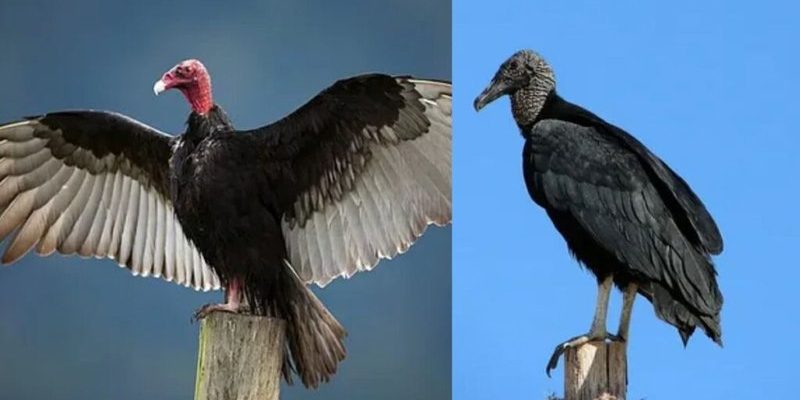![Comparing The Turkey Vulture Vs. [Similar Species]](https://gudri.com/wp-content/uploads/2025/06/Comparing_The_Turkey_Vulture_Vs___Similar_Species__image_0.jpg)
In this article, we’re diving into the world of these two magnificent scavengers: the turkey vulture and the black vulture. What sets them apart? How do they behave? Are their diets the same? By the end of this deep dive, you’ll have a better understanding of not just these birds but also their roles in the ecosystem.
Physical Differences Between Turkey Vultures and Black Vultures
To start, let’s talk about what makes each vulture unique in appearance. The turkey vulture has a long, bare red head, looking a bit like a turkey—hence the name. This distinctive feature helps them stay clean while eating carrion. Their feathers are mostly dark brown and they have a wingspan that can reach up to 6 feet!
On the other hand, the black vulture is less flashy. They sport a black head and a robust body, with dark feathers and a slightly shorter wingspan of about 5.5 feet. While they might not have the fancy coloring of their turkey counterpart, they’re strong and agile flyers, perfectly adapted for their scavenging lifestyle.
Here’s a quick summary of their physical traits:
| Characteristic | Turkey Vulture | Black Vulture |
| Head Color | Red | Black |
| Wingspan | Up to 6 feet | About 5.5 feet |
| Body Color | Dark brown | Black |
Habitat and Range
When it comes to where these vultures live, both have quite adaptable habits but prefer different environments. The turkey vulture can be found from southern Canada all the way down to South America. They thrive in open areas like fields, forests, and even near roadsides where food is plentiful. It’s not unusual to spot them perched on tall trees or soaring high above.
The black vulture, however, tends to prefer warmer climates. You’ll usually find them in the southeastern United States, stretching down into Central America. They also enjoy open areas but often congregate near urban settings or farmland where they can scavenge for food. Their adaptability helps them thrive in different environments, often in places where turkey vultures might not frequent.
Feeding Habits and Diet
Now, let’s dig into how these vultures eat. Both turkey and black vultures are scavengers, meaning they primarily eat dead animals. However, their methods of finding food differ. Turkey vultures have an amazing sense of smell—they can detect carrion from up to a mile away! This is quite unusual for birds since most rely on sight, making them stand out in the scavaging game.
On the flip side, black vultures primarily use their keen eyesight. They often follow turkey vultures in the air, waiting for them to spot a meal. This partnership lets them benefit from each other’s strengths, showcasing a unique interaction in the bird world.
Their diet can include:
- Roadkill
- Animal carcasses
- Fish
- Fruits (occasionally for turkey vultures)
Behavior and Social Structure
Diving deeper into their behavior, turkey vultures are often seen alone or in small groups. They are more solitary in their feeding habits. You might catch a turkey vulture eating quietly by itself, taking its time to enjoy its meal.
In contrast, black vultures are social creatures. They often feed in larger groups and have a more aggressive approach when it comes to getting their food. If they spot a turkey vulture enjoying a meal, they might swoop in to steal some scraps. This social behavior is essential for survival, especially in areas where food can be scarce.
Conservation Status and Challenges
In terms of conservation, both turkey and black vultures are currently stable. However, they face threats from habitat loss, poisoning from eating carcasses treated with toxins, and collisions with vehicles. It’s crucial to protect their habitats and educate others about their importance in the ecosystem.
Turkey vultures, due to their foraging habits, can be affected by environmental changes, while black vultures are more adaptable. Awareness and conservation efforts can help ensure these fascinating creatures continue to thrive.
Understanding the differences between the turkey vulture and the black vulture is more than just an interesting fact—it showcases the balance of nature. Each plays a vital role in keeping our ecosystems healthy by cleaning up dead animals and preventing the spread of disease. The next time you see a vulture soaring overhead, take a moment to appreciate its unique qualities and the important work it does. Knowing these differences helps us appreciate the diversity of life around us and encourages protection of these incredible birds for future generations.

